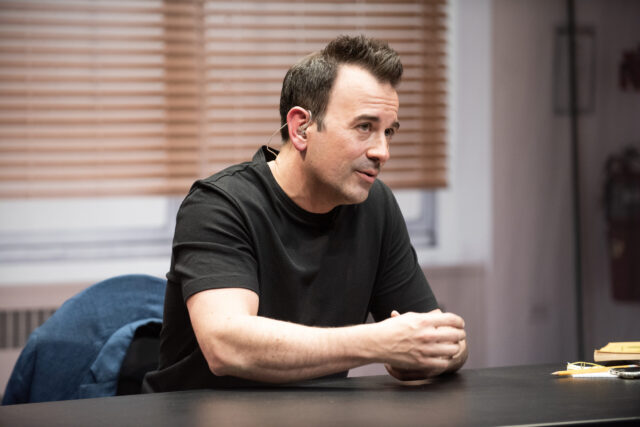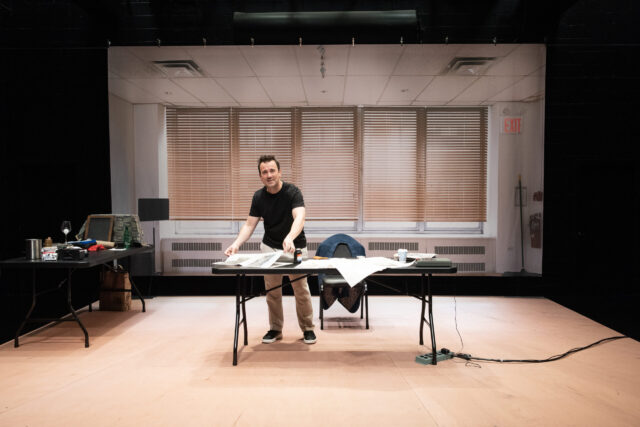
Actor, magician, and illusion designer Steve Cuiffo teams up with an unseen Lucas Hnath in A Simulacrum (photo by Ahron R. Foster)
A SIMULACRUM
Atlantic Stage 2
330 West 16th St. between Eighth & Ninth Aves.
Tuesday – Sunday through July 9, $77-$97
atlantictheater.org
Obie-winning playwright Lucas Hnath has a penchant for incorporating elements of stage magic into his works, many of which “take place in the thin place between fiction and reality, between the living and the dead, between performer and attendee,” as I wrote about his 2019 play The Thin Place, which involved ghost stories and a psychic medium. A Doll’s House Part 2 was set in a bright, heavenly room that jutted into the audience. Hillary and Clinton imagines an alternate universe where Hillary Clinton is still running for president. Red Speedo transformed New York Theatre Workshop into an active swimming pool. Dana H. is a true story told via Deirdre O’Connell sitting in a chair and lip-syncing to a recording of Hnath’s mother describing a kidnapping. A Public Reading of an Unproduced Screenplay About the Death of Walt Disney is narrated by Walt Disney after his death. And in The Christians, Hnath questions faith in God, its own kind of magic.
Hnath tackles real prestidigitation in A Simulacrum, collaborating with actor, magician, and illusion designer Steve Cuiffo, who previously teamed with Hnath on The Thin Place and A Public Reading and has also worked on such visually dazzling shows as Old Hats, Geoff Sobelle’s The Object Lesson, and Anne Juren and Annie Dorsen’s Magical.
Beginning in August 2021, Cuiffo and Hnath spent more than fifty hours workshopping the play in four sessions, as Hnath interviewed Cuiffo about his life and his career and had him perform tricks, ultimately assigning him the task of creating an original illusion that his magic-hating wife, Eleanor, would love. The workshops were recorded, and Hnath edited them down to ninety minutes, cutting out Cuiffo’s voice. Onstage, Cuiffo performs his part of the conversation live, aided by an in-ear device that feeds him his words, which he speaks verbatim.
Cuiffo walks onto the set, based on their rehearsal room on East Fifteenth St., goes over to a table, pops a cassette into a tape recorder, and presses play. Hnath is heard saying, “Um, the image I have in my mind is there might be a table and a chair onstage, and maybe at the beginning of the show, Steve comes out and, uh, there might be a tape player or a tape deck onstage, and he might put a tape in the tape deck, press play, and you’ll hear my voice, all of the questions and things I say during this workshop, and Steve will be re-creating his half of it live, something like that.” Hnath has essentially told us what has just happened, like magic; we also now understand that Cuiffo’s timing must be perfect so as not to mess up the precise dialogue, which he must deliver to the second.
Louisa Thompson’s set also includes a table off to the side with Cuiffo’s tools of the trade and a life-size photograph of one of the walls in the actual rehearsal space. Tyler Micoleau keeps it bright, mimicking the lighting from the workshops. Cuiffo looks past the audience at an imaginary Hnath, speaking directly to him as he discusses his influences and performs tricks that don’t necessarily impress Hnath even when they do impress the audience. Mikhail Fiksel’s sound design maintains the feeling that Cuiffo and Hnath are actually interacting live, although Hnath’s words are scratchy and sometimes hard to make out, as the tape recorder is an old one.

Steve Cuiffo performs a newspaper magic trick in A Simulacrum at Atlantic Stage 2 (photo by Ahron R. Foster)
Cuiffo works with a deck of cards, a newspaper, rubber bands, a coin, cups and balls, and Huggums the doll and talks about his wife and son, magic tropes, his childhood, and Harry Houdini. All the while, Hnath asks questions like a dramaturg ensuring that all the dramatic bases are covered. “I don’t know that I’m really parsing any of it,” Hnath says. “We’re losing Steve, we’re losing Steve’s voice. . . .” He adds, “I just want to see stuff I’ve never seen before.”
Hnath is also imagining himself as a member of the audience, as if he’s one of us, watching the show and determining what’s working and what’s not; several times he echoes what we are thinking. For example, the coin trick might be fun, but it’s not what we came to see at the Atlantic Stage 2. “Um, I wrote I’m interested in a trick — you creating a trick, that will always involve some kind of real failure,” Hnath says, getting to the heart of what live theater can be. Not everything clicks; some of the tricks lack a certain oomph in this setting even when they are not failures.
Later, Cuiffo admits, “So the assignments caused me . . . tremendous stress for weeks and weeks.” That kicks off an exciting race to the finish that doesn’t quite end with a flashy Vegas-y flourish.
Cuiffo is a thoroughly charming and engaging character; you keep your eyes fixed on him not just because you want to try to figure out how he does his sleight of hand but because it’s fun being in his company. Hnath, who is a participant and the director, can be a stern taskmaster and judge, but it comes across that they enjoy working together. At one point, Hnath shares a memory about how he used a magic trick as a kid to help him through a terrible fight between his mother and biological father, which hearkens to how writers reach into their own lives to create theater.
A simulacrum is a representation or semblance of something; thus, in the title alone, Hnath and Cuiffo are telling us that what we’re witnessing is not an exact science but a portrayal of something else, much like theater and magic. There’s a “Now you see it, now you don’t” aspect to A Simulacrum; you may never figure out exactly what is going on, but you’ll be glad you were there to experience it.
[Mark Rifkin is a Brooklyn-born, Manhattan-based writer and editor; you can follow him on Substack here.]